Utility Project
'#SadJacuzzi' (2014), 'Bouquet' (2012), 'Untitled' (2010) and 'Gasoline' (2007)
by Johanna B. Bodde

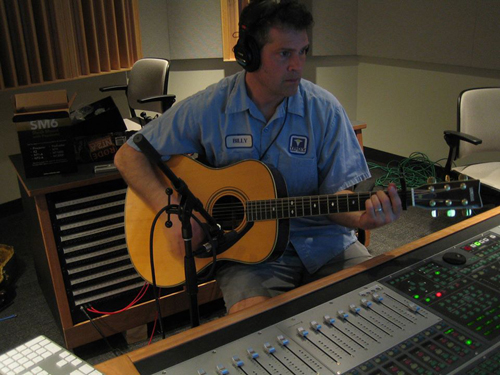


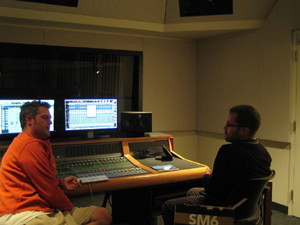 Utility Project
'#SadJacuzzi' (2014), 'Bouquet' (2012), 'Untitled' (2010) and 'Gasoline' (2007) All self-released www.utilityprojectmusic.com video: https://www.youtube.com/watch?v=YFXIjrof9h4 ----- This is a review that wouldn't fit in anywhere
else. I hope you are in an open-minded mood today! This is all about an unusual
and rather genius combination between avant garde music and a lot of science. I
first heard about Doyle Dean and his Utility Project from our mutual friend Sean
O'Brien (see elsewhere on this Insurgent Country page), who sent me the disc
'Gasoline' (2007). It was meant to be left, after listening, at the gas pump.
The songs were created by using a code, partly existing of oil company
statistics. 'Untitled' (2010) was created using coin tosses and by referring to
the Chinese Book of Changes, the I Ching. Definitely interesting enough for
me and spell-binding in a strange way! After
making contact with Doyle, I found out he is a very nice, very funny and most of
all extremely smart guy. I mean it - there was definitely no payola involved! I
think he deserves some space here to explain about all the things he
creates.
Consider this: What if writing music was left to chance? A process where
notes or chords are determined by the roll of dice or flipping a coin? Music
that, essentially, writes itself. Decades ago, John Cage pushed the boundaries
of writing music by using coin flips to decide where or how to place a certain
note on a score.
A Potsdam musician is experimenting with this radical approach to creating music. Doyle Dean, former punk rock band drummer and filmmaker, talks in his home studio about his philosophy of music, some of his latest work and his utilitarian approach to pop / rock. In an email tag, Dean quotes himself, "I set out to re-define popular music
but discovered a new way to create extremely unpopular music instead." He writes
songs that use chord and drum patterns randomly selected by dice rolls. He burns
CDs with his songs and leaves them at places like truck stops, hoping the random
people who pick one up give him feedback.
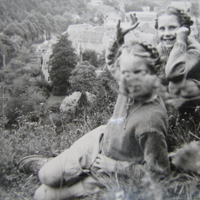 '#Sad Jacuzzi' is a rather normal
album to Doyle Dean standards. It makes a combination of rock with electronics.
He created it together with Jerod Sommerfeldt and his computer.
Doyle Dean in his own words: "Almost exactly five months ago Boy Genius Jerod
and I spent a couple of hours in the studio - a state of the art recording
studio that basically fell in my lap that year. We both wore headphones, he laid
on his belly typing on his laptop and I sat at my drum kit. We recorded basic
tracks for six tunes that day, adding two more later. Over the Summer they took
shape as songs as we overdubbed guitar, bass, vocals, etc. A concept of duality
finds its way into the material. Working as a pair, it was the first time I
collaborated to such an extent on a record. We tried to explore the conflict and
cooperation of man and machine. Our basic tracks, in fact, were created by
plastic and wood, a laptop and a drum kit. Maybe this translates? Maybe it
doesn't. Sounds pretty high-falutin' but a storyline evolved... more suggested
than dictated... The songs essentially span a lifetime, from birth "Isn't She
Sweet" to death "Dust" and beyond "(Do The) Resurrection". One could argue
conception as well with "Seed Pirates" and "Two Places"? We finished recording
in early September and gosh darn it, are happy with it and hope you enjoy it
too! I tried to get the cover onto t-shirts, it just didn't work, everything
turned to mud, so here's a completely unrelated drawing of a polar bear done by
my son. Thought it looked cool, hopefully you do too." Greetings from Potsdam,
New York, 10.22.14, Doyle.
A collaboration with Electronic Music Composer Jerod Sommerfeldt. The first Utility Project record in two years! The disc comes in a handsome EcoPak, a step up from standard Utility Project fare. Featuring original vintage photographs and a # hand stamped for each individual copy. Limited Edition numbered CD (Edition of 100) 11x17 poster ready to wow your classmates at school or brighten up your depressing cubicle at work - Poster Edition of 60 -----
Eight tracks, to a total of 32 minutes. My numbered disc also says '32', from a total of 100. I like the black and white lay-out, but then again: you can always lure me in, using a vintage photograph! The first two tracks ("Two Places At Once" and "Seed Pirates") sound rather monotone to me, especially the mechanical, somewhat on purpose off-key singing, although I start to like a few of those little circling sounds, the drumming is more than O.K. too. Then... "Isn't She Sweet?" is a very nice, spacey duet with vocalist Laura Brown. "Isn't she sweet / Our falling star / Isn't she sweet / We can track her to Mars." "Drive" turns out to be an instrumental track with soundbites and I hear a lot of bleeps & blops around my ears until the sound stops to an abrupt end. "Jaws Of Life" probably comes closest to what we know as 'regular' songs. It starts off with a well-meant: "Wake Up!" Laura Brown provides sweet harmony vocals again, the lyrics about a car crash are interesting, realistic and hopeful at the same time. The chorus sounds like a children's Christmas song. In duet "Dust" a cello (played by Beth Robinson) and a saxophone (Andrew Lammly) are added for the very pretty alternative folk arrangement of the longest track on the album. "You'll have my hand to hold while this beautiful mystery unfolds." "Keep On The Sunny Side Of Life" is -indeed- a cover of the classic song, Bill Vitek plays the piano and Laura Brown sings! It feels like a long lost piece of a very old film was restored and showed again on one of those vintage projectors... Intriguing and beautiful. The last track "(Do The) Resurrection" features uptempo, frantic singing, a background of noise and even a fearful clarinet! "You don't want to miss this / It's the resurrection". This advice from the cover: "Utility Project CDs have a way of getting around. If you found this disc please take a moment to listen and then please pass it on. Thank you. All previous Utility Project releases and the karaoke version of this record can be found at BandCamp." A record like no other! Yes, it definitely has
several pretty pieces, but a couple of other tracks do next to nothing for me. I
admire what's going on, I keep being mesmerized, I wonder what Doyle comes up
with next! Despite his advice, I definitely leave the CD in my collection - I
won't pass it on! NO, I won't!!!
-----
 DOYLE DEAN talks about 'Bouquet': "I embarked on the 'Bouquet' project in the Summer of 2010 when I asked Mads Haahr of RandomOrg to write a program utilizing his 'space sound' randomizing super powers to generate random number sequences that I could then translate to Utility song-speak. The result was the Utility Song Maker! I gave Mads a list of questions that I needed answered and told him the possible number of answers to have. These 'questions' included: Tempo (3 possible answers), Rhythm (6), Time Signature (8), Drum Sound (6), Song Structure (7), Number of Chords (1-7) and Special Attributes (1-10 choices). I used the standard RandomOrg integer generator to determine the chords within the songs (38 choices) as this is a 'second tier' activity. I know this is a lot of mucky muck confusing stuff but just picture an Excel spreadsheet, here, here's my spreadsheet: notice that song #1 for example, "Grady Martin", has 'radio ad' as its special, it's in 4/4 time, the drums are 'funk/swingy', tempo is 'F' for fast, song structure is 'ABC', number of chords is '4' and the chords themselves are 'Ebm, Eb, Ab and F'. All of these decisions were made randomly by RandomOrg. Getting to the subject / lyrical content was another matter. I called my friend Kjehl Johansen and the two of us sat at our computers on the Wikipedia website. We took turns hitting the 'random article' button, each time fulfilling the subject matter obligation for a song. And I should note, cackling with laughter like a couple of six year olds. One time it was Ian Michael Chappel, a South Australian cricketer, another time it was the Visa Requirements for Sudanese Citizens, pop music gold. We continued until we had sixteen. I did abort a song, one that would have been between "Empires Falling" and "Nixon Judicial Appointment Controversies". The song was tentatively called "Life Ain't Easy" which became quite relevant while working on the tune. R.I.P. song "G". Oh yes, then why are there 16 songs? Well, I added one, "Bouquet (The Thank You Song)" when I 'kickstarted' the project, a special way to thank folks who forked out seed money. And yes, thank you for asking, I DID use random methods to determine the chords to play. I stole an unused drum track from "Grady Martin" and added two randomly determined chords, I don't remember now what they were. But you probably don't care anyway. Like all previous Utility Projects I will be leaving some CDs in public to be passed on, sending them out into the world the same way they came into it, the liner notes read 'if you found this disc please pass it on'. I will also be selling the discs as they're still available. Maybe you'll FIND one and then you don't need to shell out 8 bucks! O.K., that's the random part, now on to the recording, or... trying to make sense of the mess... Doyle wrote on top of the print: "Thank you -
Here's some reading material about my project if you're curious - EVERY great
record requires four pages of explanation, right? Cheers - Doyle". I told you:
he has a great sense of humor!
DOYLE DEAN talks about the
tracks:
1. "The Grady Martin Show": Guests: Drew Coles (Saxophone); Todd Moe (Voice Over). The special (self) assignment for this one was to create a radio/tv theme song. I didn't THINK it would quite work out, but I did my best to stick the spirit of the challenge. The chords are played as ordered and then were reversed after the voice over with the same drum track. I wrote a little v.o. for Todd to read and it was so dry and lame that I decided to 'utility-ize' it by keeping small words like 'the' and 'a' but taking everything else through the Meriam Webster machine. I replaced each word in the script with the word that preceded it in my (real paper) dictionary. So, a phrase like 'It's the Grady Martin Show, Starring Grady Martin' becomes 'It's the Graduation Martian Shovelnose! Stapler Graduation Martian'. Much more interesting the second way, don't you think? I give Todd a lot of credit for not only getting through the script but for maintaining the appropriate read throughout. I could not have done that. And I could not have played the sax like Drew either! He's great. Thanks Drew. Grady Martin was a session guitarist in the 50's, 60's and beyond. That's Grady Martin playing the 'Pretty Woman' riff in the Roy Orbison tune. Brilliant and simple. Grady, to me, was all about the hook. Thank you gods of random for finding Grady for me. It was fun to pour through the vintage footage of Grady -just part of the band- playing on some great old tunes. He seems like he was a decent human being as well. Hope you're o.k. with this Grady. 2. "Patagonia": Guest: Hanna Rosen (backing vocals). The special assignment here was to create a guitar chord from the randomly selected chords -using the rootnotes- and playing it throughout. So that's one chord you hear over and over. There are some changes on the bass that keep it going and I think my second guitar part does a little off-chord stuff. If I did it right I think it's D, F, A, C#, E. Hannah saved me on this one. I was really happy with the instrumental version but struggled (as usual) with the vocal. Hannah was able to do what I was trying to do and I will admit that I copied her ghost vocal on a couple parts that she only sang as roughs. The subject matter from Wikipedia's random article feature was: Chubut Rawson, an area of Argentina near a river that was part of an area settled largely by the Welsh in the 19th century. As a USAmerican I find it fascinating, we learn so little in school about South America and about cultures merging other than our own. We are so USAmerocentric. 3. "Humility, Underlined": Guests: Knowle'ge (vocal flow); Brian Lotze (trumpet). I had been wanting to collaborate with a hip hop artist for years now. So I gave myself the assignment. Song C would feature a 'rap'. Knowle'ge really impressed me, he agreed without hesitation and was able to create something very much his own within an odd (3/4) time signature amongst the Utility 'alt rock' machine. I had told him about the subject matter for the song (a road in Ireland called the R116) but he either ignored this or forgot about it, I'm not sure. We recorded his flow first, before I really had lyrics and when I heard it I was blown away. The song suddenly became more about me being open to change and allowing myself to gain some Knowle'ge. 4. "Gustav Mutzel": Guest: Captain John Kaplan (bagpipes). The special assignment for this tune was to have been to incorporate a marching band into this track. I nearly did it, but negotiations fell through. (THIS time). So I turned to my friend in law enforcement who plays the pipes. John was a bit concerned after hearing what he'd played. He is a humble piper and has been out of regular playing for a while, he heard all the warbles and wasn't sure how he felt about. I hope I've done him justice by pointing it out lyrically along with the other flaws inherent in the world of Utility Project. The first line of the song is: "The piper warbles and the drummer can't keep time" so there it is, done, we know there are warbles. It's o.k. The song is about a German illustrator with a name destined for pop song stardom: Gustav Mutzel. After learning about Mutzel's technical skills with a pen and having committed myself to addressing the warbles I wondered what it might be like if Mutzel could come back and help the band. I don't know what 'the band' would do with a German illustrator who has been dead for 100 years, but we'd find SOMEthing. 5. "Roxborough Castle": Guest: Sean O'Brien (lead vocals). I played with Sean in a band called The Mariettas back in the late 90's. I played drums on one of his records a few years ago and have been wanting to get him to sing on a Utility Project tune for a while. I believe Sean recorded the vocals right onto his laptop at home in Northern California, then he emailed me the file. The subject matter for the song is Roxborough Castle, um, just like the title. I did some research and was not able to confirm whether or not the burning of this estate in the far North of Ireland was accidental or an act of aggression. For the song's sake we'll sort of assume it was. 6. "Katyn": Guest: Maxwell Howard (piano). My apologies to Tom Baker for the aborted version of this song. Tom played some very nice banjo and other goodies which never made it into the final tune, but we shall finish the track another time. Max Howard came and laid down some piano once I had the bass and drums in place. The 'special' for this song is 'whisper quiet' sadly? This is about as quiet as I am able to be, I kept the arrangement spare, but I wouldn't exactly call it 'quiet'. The assigned subject matter for the tune was 'Bialystok-Grodno District' an area occupied by Germany during World War 1. Part of this 'district' later became host to the Katyn massacres of the 2nd World War. 7. "Richard Nixon Judicial Appointment Controversies" (instrumental): Guest: Ralph Lichtensteiger (soundscape). I've been collaborating with Ralph for a few years now. It's great fun to embark on a project and ask Ralph to 'send me something'. I told Ralph the song's title and the chords (Fm, Em, Bbm). He sent me something pretty cool about a month later, the file was called 'bacon'. I'm not sure why. Yummy. I took Ralph's soundscape and manipulated it. I then voiced an article on Richard Nixon's Judicial Appointment Controversies and manipulated that. I did a few overdubs and it still seemed lacking. So I dug up an unused 'Grady Martin Show' drum track and pulled it over to this tune, than added a bass. 8. "Empires Falling": Guests: Beth Robinson (cello); Drew Coles (saxophone). The song structure for this one is: ABCAAC, so sadly, I only got to play my favorite part once. Drew amazed me. The part where the sax first comes in seemed awkward but when Drew played over it he was able to take that and really swing it. Go Drew! Beth came and added cello. It's so nice to hear them play 'together'. Beth played a nice intro, too, though she didn't know it at the time. The subject matter for this tune was a painter named Fausto Zonaro. He was born in Austria and educated in Italy in the mid-late 1800's. In 1891 he was asked to come to Turkey and later to be a court painter for the Ottoman empire, which fell a few years later. He was forced to return to Italy with his family and later got divorced. I wondered what this 'fall' might have done to him. 9. "Ronnie Listner Is A Bobsledder": I was chasing a collaboration that didn't happen, maybe next time, you know who you are! Early on I was doing a bass overdub and realized it was sharp so I redid it. But then I accidentally heard my re-do along with the sharp bass and liked the sound. It reminded me of early Wire. It's kind of buried in the mix now, but maybe if you squint... After months of work I thought this one might be a throw away until I talked to my daughter's piano instructor about backing vocals. Without hearing the tune she suggested starting with a dissonant note and resolving into a 'proper' one. It worked! The subject for this one is, of course, Ronny Listner. Ronny works at a prison when he's not bobsledding for the German national team. I happen to live pretty close to Lake Placid. I was hoping to shoot some footage of bobsledding during the world championships, alas, a certain media company owns all of the rights. And now it's March and it's 80 degrees for some reason. I'm not sure if Ronnie was here sledding this year. But let's assume he was. 10. "Saint Mungo": Special for this one? Glad you asked. Record and then digitally edit the drums. I recorded a drum track using all of the pre-determined rhythm information (5/4 beat, ABC structure, S = slow - I can't play SLOW! But I try). I used RandomOrg to locate three different sections to loop - I think they're 1/2 second sections? I can't remember. Then I ended up with a few minutes of rhythmic insanity. I was finally happy with the music track and struggled to find a vocal melody. The subject matter for this song was 'Chronological List of Saints of the 7th Century'. I just started reading through the list and Mungo stuck out. Saint Mungo is the patron saint and founder of the city of Glasgow. 11. "Still Life With Dead Bolt": Guest: Brian Lotze (trumpet). Special here? 'RandomOrg space noise'. Mads can explain it better than me, but my 'idiot' explanation goes like this: "RandomOrg has a receptor perpetually gathering noise from outer space that it then translates into true random integers." I am not a scientist, what do you want? I took some of this noise and manipulated it (um, flanger? phaser? I don't remember) and looped it. I thought it made a nice backing track. The subject matter for the song was 'Upper Sapey' a hamlet - not really a suburb I don't think (to be fair) approximately 110 miles from London. There wasn't a lot of information on Upper Sapey but I did find some real estate and then things took a turn for the worse one day when I found myself locking myself inside for no particular reason. 12. "Sledge": Guest: Kjehl Johansen (slide guitar) (So angry that I somehow omitted Kjehl from the CD jacket collaborator list!) Kjehl has been a Utility Project collaborator from day one. For this project Kjehl and I gathered the random information together while on the phone and Internet. It was predetermined that this song would feature Kjehl and after I sent him the drum track he recorded some nice slide in Los Angeles and sent it back. The subject matter for this song was a South Australian cricketer named Ian Michael Chappel. He was active in the 70's and 80's and later went on to broadcast the sport. He became rather famous for 'sledging' short for 'sledgehammering' or trash-talking during matches. 13. "Occupy Seether": Guest: Hannah Rosen (vocals). This is the last song that I completed, I had a version I was happy with, but it just didn't make sense with two Doyle voices. I was able to convince Hannah to come record again. Thanks Hannah! The subject matter assigned here was 'Seether Discography'. I had never heard of the band Seether, but checked them out and quickly remembered hearing the song 'Fake It' (many times) a few years ago. Not a bad tune. So my challenge was to somehow get the band's discography into the lyrics. The Occupy Wall Street movement was just gathering steam when the song was written so I imagined a couple meeting at a rally and not really giving two hoots about the cause but being more interested in comparing notes on their favorite band. 14. "Visa Requirements For Sudanese Citizens" (instrumental): Guests: Amy Swartele (paintbrush); Tom Baker (banjo); Brian Lotze (trumpet); Drew Coles (saxophone); Max Howard (piano); Manfred Hofer (vocals via answering machine). Special: 'Amy Paints'. I wondered what it would be like to surrender rhythmic information to something that doesn't typically have a discernable rhythm. Amy was kind enough to come over and paint on sandpaper for me. The idea was that other instrumentalists would layer their takes responding to the sounds that had been left there. Almost like a collaborative audio mural (?). Manfred 'phoned in' his performance tying it all together. 15. "Amazon Death Bus": Guest: Brian Lotze (trumpet). The special here was 'b/w horn solo'. Curiously, because when the trumpet is played well -like Brian does- tone is tone - backwards or not, so we had to try a couple of different things here to actually be able to tell that it was coming at you backwards. Can you tell? I can tell. Subject matter: 'Balzar Canton' an area of Ecuador not too far from a place that some friends visited. They told me all about a terrifying bus trip they had. They also told me about a rooster watching television. But the bus seemed like a better fit for this tune. Maybe next time, couch roo-tato. 16. "Bouquet (The Thank You Song)": It's a shameful sellout to kickstarter, I hope my 'backers' don't mind me rhyming them up. -----
|
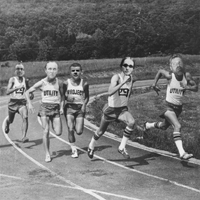 Doyle Dean talks about 'Untitled' (2010): The Utility Project 'Untitled' was created using coin tosses and by referring to the Chinese Book of Changes (the I Ching). The I Ching consists of 64 chapters. A chapter is chosen for one consulting the book by using various methods. The most common modern method is by tossing three coins six different times. One meditates and then tosses coins. Six lines are drawn, broken or unbroken, (yin or yang) based on the results of each coin toss. The 17 chapters on this record were chosen by tossing coins in this way. The songs appear in the order in which they appear in the I Ching. Each song is named after and based on the I Ching chapter that it represents. The next step in the process was to determine the rhythmic information for each song. I referred to the information above for that. If the bottom line (first coin toss) was a "yin" line I played a slow drumbeat, if it was "yang" I played fast, and if it was a "moving" line (ie: all heads or all tails) I played medium tempo. Likewise the beginning drumbeat was determined this way. If the fourth line was yin I started on the hi-hats, if the fourth line was yang I started on the ride cymbal, and if it was a moving line I started on the toms. I consulted the 5th line (second from the top) to determine which percussive element to emphasize on the following part of the song and so on until each song had three potential drumming elements ready. I realize that as much as I try to break with convention I am a slave to it. In order to create the kind of music that I like to hear I use repetition. There is certainly merit in breaking with this but with this project, given the many possibilities that chance methods presented to me, I thought it best to stick with a pop/rock formula. I used mostly 4/4 time, repeated elements, and generally adhered to a verse, chorus, bridge song structure. The next concern was to determine the chords to be played. I tossed coins to produce a number between 1 and 8 so that every song has between 1 and 8 chords in it. Eight is an arbitrary number, a manageable number of chords for the purposes of my playing. Once I knew the number of chords to be played I had to determine which chords they would be. I took a chart of the I Ching and arbitrarily assigned chords to each of the 64 chapters. I then set about rolling coins to build the chapter structures (or gua) having the chapters reveal themselves to me as they came forward with solid or broken lines depending on each coin toss. I tossed a lot of coins. After creating a spreadsheet with information dictating the rhythmic information, the tempo, the subject matter, the title, and the chords to be played it was time to set about recording it all. I recorded the drums first. Then the guitars and bass. Lastly the lyrics were written and vocals were recorded. I was taken aback by the soul searching that some of the assigned chapters required me to do. I am used to writing lyrics about objects, events, or historical figures. This was a real challenge for me. I had to write about hopes, dreams, humility, and power. I was truly out of my comfort zone, which is the purpose of working this way in the first place. I had to consult some chord charts to come up with 64 chords and chose to use diminished chords this time. This also proved to be a challenge. They never sound quite right. This gives a nice twist to some of the progressions but singing over a diminished chord is not the easiest thing to do (even for people who CAN sing... so they tell me...) The disc is available on CDBaby and thru the website for a limited time. 1,000 individually numbered copies are in print. Most of these will be left in public and passed on from person to person. The music goes out into the world the same way it came into it, by chance. -----
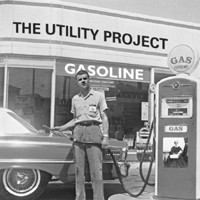 Doyle Dean talks about 'Gasoline' (2007): I realized while distributing discs for the two previous projects that the one place I was generally unobserved but in public was at the gas pump. I thought that it would be fitting to marry the concept with the distribution method. Eric Braysmith and I designed a system to create 21 songs for the project Gasoline. One method uses human information (like 1 32) and one uses oil company statistics. For the odd numbered songs a code was created pairing the most commonly used letters in American English with chords. The songs essentially spell out the first and last names of people who helped shape the modern oil industry. All creative decisions were based on information gathered specific to the individuals. Birth dates determined rhythm and tempo, and individual histories inspired the lyrics. For the even numbered songs a different code was used. The code pairs an alternate version of commonly used letters with the most common chords in the most common keys. The songs 'spell out' each oil company name. Song structure, time signature and tempo are determined by information specific to each oil company. Age groups were assigned to each oil company song and anecdotes were gathered from various individuals to supply lyrical content. ---
A piece from 2008 about 'Gasoline':
You can't buy Doyle Dean's new CD in the music store, but you might pick it
at the gas pump.
The inside sleeve for the disk, titled 'Gasoline', offers an action illustration and instructions: "This Utility Project CD fits nicely in the gas pump nozzle holster. Please place the disc here next time you fill up." It's the latest random act of non-commercial art from the filmmaker, artist and musician (who then lived in New Harmony, IN). Like two previous releases in his Utility Project series, Dean created this recording to pass, not to sell. The project has its own website, where finders register and leave comments. Underwritten with grants, contributions and fund-raising events, The
Utility Project has used dice rolls, codes, mathematics and human stories to
create mainly rock songs on three CDs intended to be left, listened to, perhaps
copied, and then left for others to pick up on bus benches, bathroom sinks and
other public places.
For 'Gasoline', controlling compositional factors include alphabetical and numeric codes that translate names of people and companies associated with oil and the automotive industry into chords and tempos. Individual contributors' automotive and gasoline-related anecdotes provided lyrics for the recording's two dozen songs performed in English, Spanish and German. Song titles include "Wankel" (for the rotary engine), "Henry Ford," "Rudolf Diesel," "Gasoline Dreams," "Boneshaker" and "Poseyville." Local collaborators who either sing or speak on the CD include painter and cartoonist Matt Billman, artist and assistant gallery director Erika Myers-Bromwell, poet and writing teacher Matthew Graham and public radio host Kenton McDonald. Eric Braysmith, a muralist, photographer and film teacher, helped code time signatures. If you want a copy without taking your chances at the gas pump, contact Doyle arranging to cover postage. "I'll send out a disc for a limited time as long as they promise to pass it on," says Doyle Dean. He takes the project seriously, but with a sense of whimsy, as reflected in his e-mail signature quote: "I set out to re-define popular music but discovered a new way to create extremely unpopular music instead." ---
An interview from 2006 by Noah Adams (Copyright NPR). Noah Adams: Let's say for the New Year to come you want to write a song, always wanted to do that. But instead of scratching your head waiting for the muse to strike, you decide, well, maybe I'm over-thinking this deal, maybe I would be just as well off creating songs by leaving it all to chance. And that is how the song you're listening to right now was created. It's by Doyle Dean, a former rock drummer, now a stay-at-home dad, living in New Harmony, Indiana, and here's Doyle describing his process. Doyle Dean: I will roll dice and determine which drumbeat to play first, and then play that drumbeat and record it, and then move on to which chords are played by the guitar and notes by the bass, and they'll be determined also by dice roll. But to make sure that they make sense as songs, I will use randomly determined song templates. So I will take existing songs that my friend or maybe I have written, their pattern, like AB-AB, and replace the notes or the chords one at a time. N.A.: Dean wanted people to listen to his little musical experiment, which he calls the Utility Project. So he put these randomly created songs on CDs and left them at randomly chosen places, like truck stops and gas stations. He also put his web address on the CD's sleeve, so people could send him feedback. Here's the story of how one woman found her copy. D.D.: She bought a Coke from the machine and out popped a Utility Project CD. N.A.: The CD pops out of the Coke machine, you said? D.D.: It didn't exactly pop out, I don't guess, but she probably grabbed a CD when she was expecting to grab her Coke. N.A.: Oh, you put it - you put it there. D.D.: I put it there, yeah. And my favorite part about her story was that she thought it was a really cool idea but she didn't like the music. N.A.: As it turned out, Doyle Dean did communicate with her as a sort of musical pen pal. And then he wrote another song about her initial reaction. D.D.: (Singing) A cool idea I thought, but I didn't dig the tune. N.A.: And now we're deeper into the story. Doyle Dean wasn't just experimenting with random notes and chords; he was writing songs about the random interactions he had with random people. And people he'd never met before started commissioning songs from him using information from their lives. They weren't only strangers. He used the same random method on the song for his mother. D.D.: And that's a story about my mom. I'd grown in rural Mississippi and she had this, you know, basically shack that she was raised in and one summer it was so hot she just cut a hole in the wall to let some of the - some air into the house. And that just stuck with me as something completely absurd. N.A.: Doyle Dean sites the experimental work of composer John Cage, and says he has no plans to inject order into the chaos of his music. D.D.: I wanted to take choice away from myself, and that challenges me, because it puts me in a corner, but it's also liberating because I don't have to decide or second guess myself. N.A.: There are now 2,000 of his CDs out there randomly floating across the globe, and each one carries the chance of another random encounter and the potential for a new random song. -----
Written by Doyle Dean and Johanna J. Bodde -
December 6th, 2014.
=====
 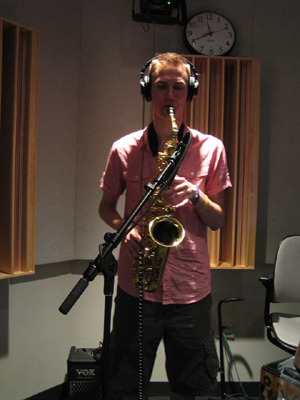 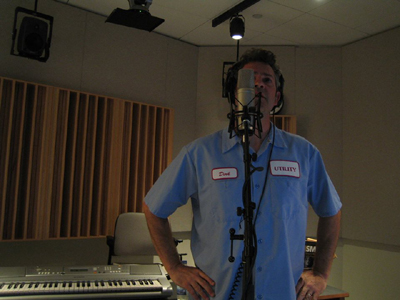 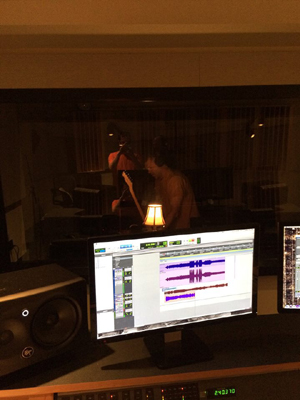 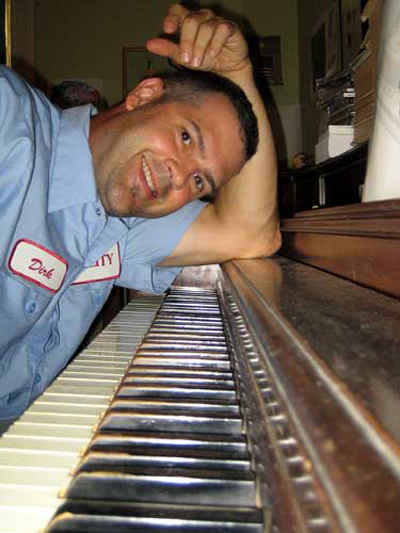 |